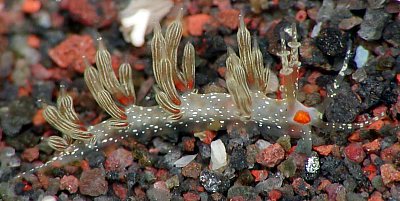
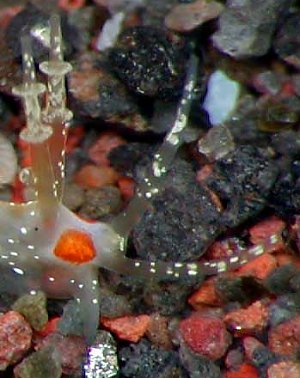
Cratena affinis
(Baba, 1949)
Order: NUDIBRANCHIA
Suborder: AEOLIDINA
Family: Glaucidae
PHOTO
Osezaki Suruga Bay, Japan, 9 Nov. 2002. Approx 7mm long. Depth: 9m. Photo: Jun Imamoto.
This photo fits the painting in Baba (1949) of Hervia affinis in all major respects. In particular the two large flattened rings on the rhinophores are very distinctive, and so are the inflated cerata which abruptedly end in a thin tapering papilla at the tip. Baba notes the body is covered in white spots, as is in this photo, and describes the cerata as having fine, longitudinal, opaque white lines and a dark digestive gland. It also has the red patches on the sides of the head the Baba describes. The onky major difference is that the ceratal digestive gland is not black, but that colour is most probably determined by the stage of the feeding cycle and the colour of the food. Described as Hervia affinis, the most appropriate genus for this species must wait until more material is examined.
Note added 2 Dec 2002: Photos of a very similar looking animal, also from Japan, were initially thought to be a colour variation of this species. They have the same characteristic ceratal shape and arrangement, and red patch at the base of the cerata, but they lack white lines on the cerata and the flattened rhinophore rings appear to be in the form of radiating papillae. See message below. I have placed photos concerning this 'form' or 'species' on a separate page as Cratena cf. affinis until their relationship to each other is clarified.
Reference:
• Baba, K (1949) Opisthobranchia of Sagami Bay collected by His Majesty The Emperor of Japan. Iwanami Shoyen, Tokyo. 194pp., 50 Pls pages.
Rudman, W.B., 2002 (November 25) Cratena affinis (Baba, 1949). [In] Sea Slug Forum. Australian Museum, Sydney. Available from http://www.seaslugforum.net/find/crataffi
Related messages
Re: Cratena affinis? from Japan
December 4, 2002
From: Nishina Masayoshi
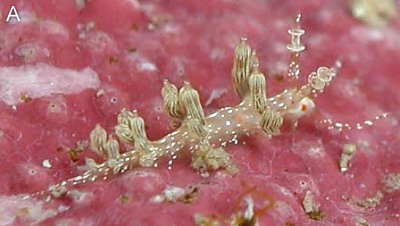
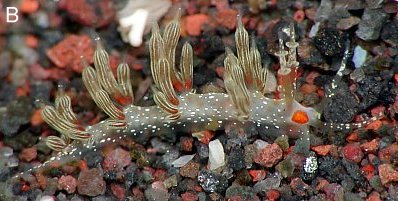
Dear Bill,
Concerning Jun Imamoto's recent message on Cratena affinis. Afterer he sent the message, he and I have tried to re-sort some animals which have similar external features.
Type A: This has almost perfect external features of C. affinis as described by Baba.
Type B: This is the same photo that J. Imamoto already sent to you. As you said the only difference is the digestive gland colour, This red digestive gland colour always appears only around the base of the cerata like that. I feel this is maybe a color variation of Type A.
Type C: [see photo below] This has different external features. The animal has no fine, longitudinal, opaque white lines on the cerata, there are white dots on the cerata or white area around the tip of the cerata instead of the lines, there is no orange or red patch on each side of the head, the body is covered in white and orange-yellow specks. The upper half of the rhinophore is white, next, an orange band continues. Perhaps, this animal and Dr.Gosliner's animal Cratena sp.1 in his book Nudibranchs of Southern Africa are the same. I also feel the shape of the cerata is bit different from Type A and Type B.
These animals are rather common on Hachijo Island and Izu Peninsula, Japan, but very difficult to find and photograph because of their small size.
Best Regards,
Nishina Masayoshi
Jun Imamoto
nishina@wips.co.jp
Masayoshi, N., 2002 (Dec 4) Re: Cratena affinis? from Japan. [Message in] Sea Slug Forum. Australian Museum, Sydney. Available from http://www.seaslugforum.net/find/8517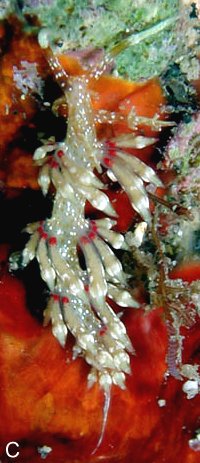
Dear Nishina & Jun,
Thanks for your thoughtful observations. I would agree that your type A and B are just the result of food in the digestive gland. Concerning type C, I agree that the differences are of a more significant nature than between A & B, in particular the lack of white lines on cerata and lack of red patches on the head. However the general shape of the cerata and the body are very similar so it is possible they may turn out to be variations of one species. One thing I do notice in your photo alongside of Type C is that the flattened rings on the rhinophores seem to have been replaced by a radiating set of papillae. If you could send a photo showing this more clearly it might be useful. At present I think I will move 'Type C' to a separate page, Cratena cf. affinis, until its relationship to the more 'typical' form is determined.
Best wishes,
Bill Rudman
Cratena affinis? from Japan
November 26, 2002
From: Jun Imamoto

Dear Bill,
I found this sea slug which looks like the original description of Cratena affinis. It seems to differ only in the colour at the base of the cerata. I would be very happy to hear your comments.
Osezaki, Suruga Bay, Japan, 9 Nov. 2002. Size approx: 7mm., Depth: 9m (Night Scuba Diving). Temperature: 17 C
Best Regards,
Jun Imamoto
http://umiushi.zive.net/
imamoto@wips.co.jp
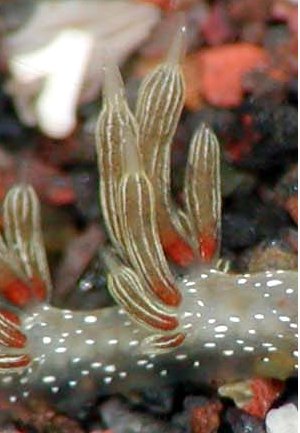

Dear Jun,
Thanks very much for these photos. I agree that this fits Baba's description very well. It differs, as you say in the internal colour of the cerata. Baba describes the digestive gland colour as 'dark', and they are blackish-brown in the illustration. I am sure the difference in your animal is because it has not fed recently and its digestive gland ducts have no food in them. I suspect the other photos on this page, which I have previously identified as C. affinis, are variants in which the white lines on the cerata are absent or replaced by white spots.
Best wishes,
Bill Rudman
